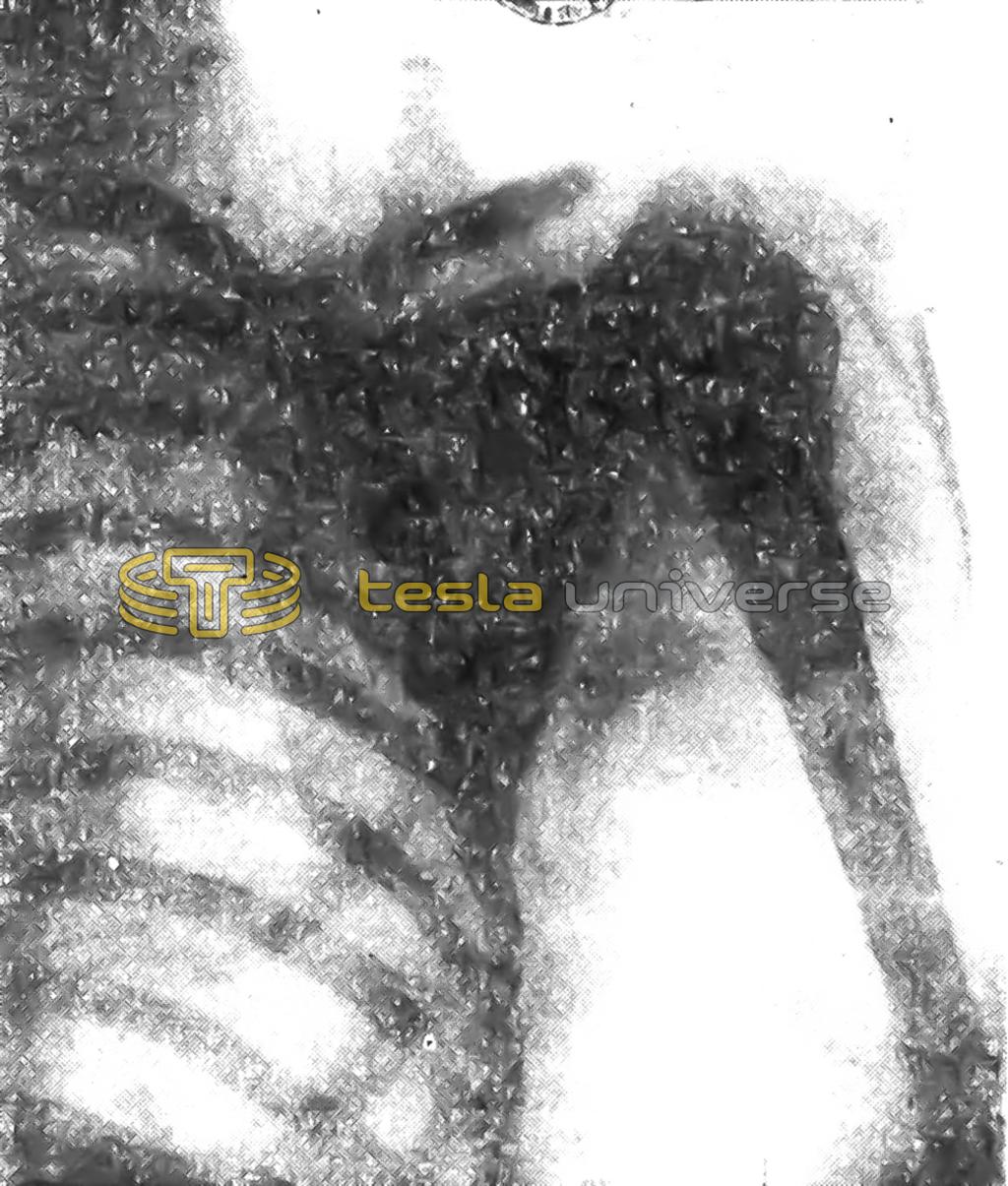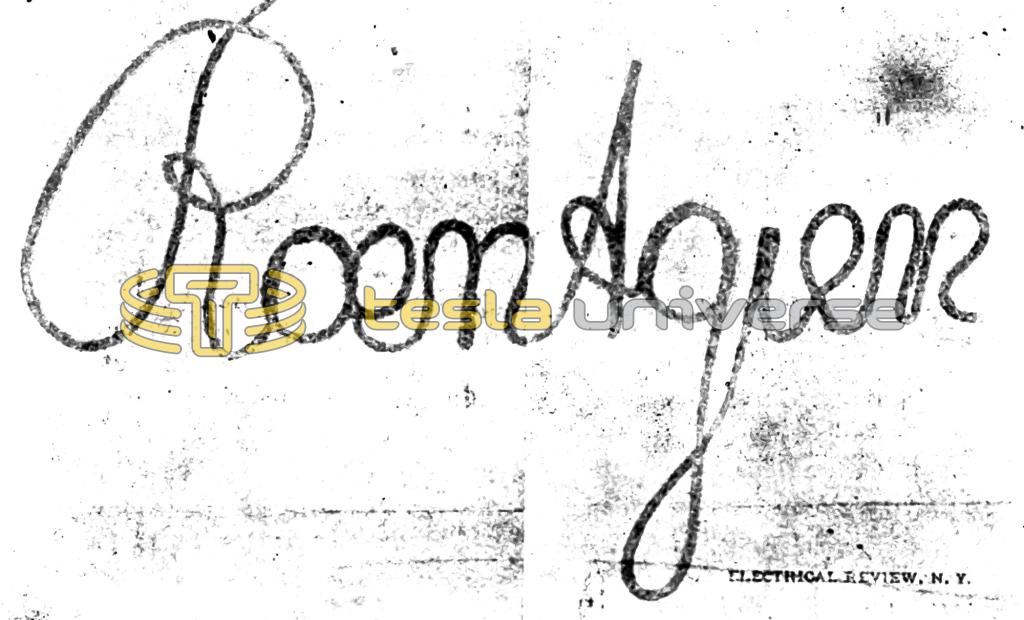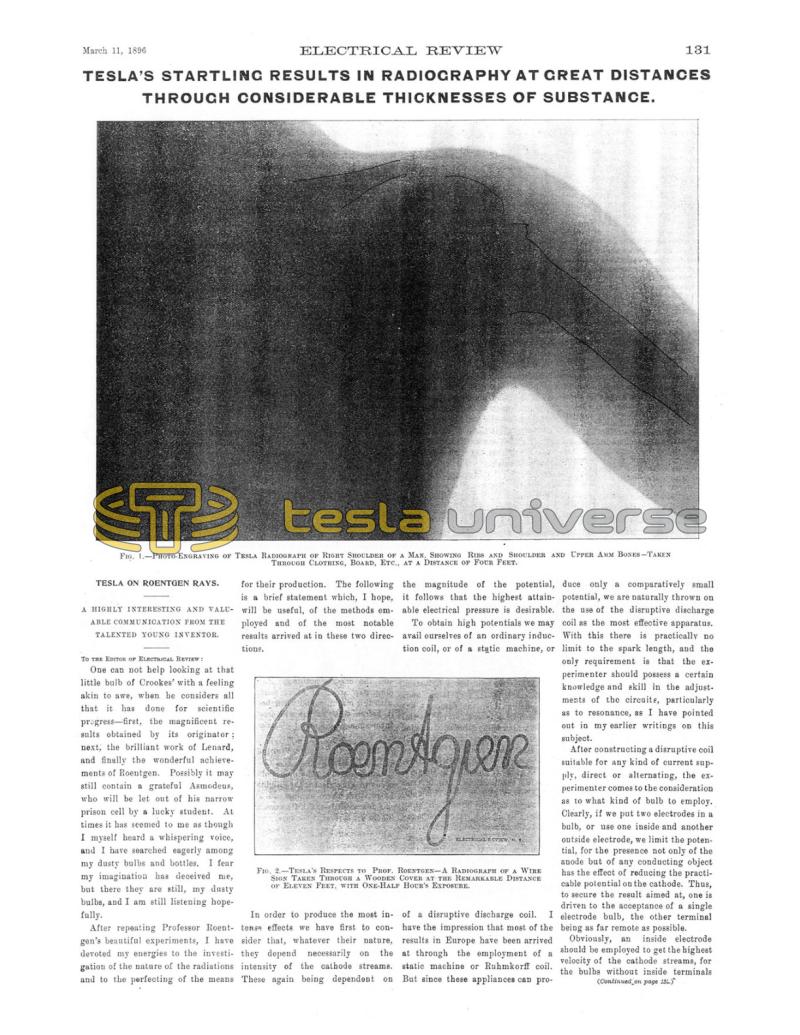
Nikola Tesla Articles
Tesla On Roentgen Rays
Tesla's Startling Results in Radiography at Great Distances Through Considerable Thicknesses of Substance.
A Highly Interesting and Valuable Communication from the Talented Young Inventor.
To the Editor of Electrical Review:
One can not help looking at that little bulb of Crookes with a feeling akin to awe, when he considers all that it has done for scientific progress — first, the magnificent results obtained by its originator; next, the brilliant work of Lenard, and finally the wonderful achievements of Roentgen. Possibly it may still contain a grateful Asmodeus, who will be lot out of his narrow prison cell by a lucky student. At times it has seemed to me as though I myself heard a whispering voice, and I have searched eagerly among my dusty bulbs and bottles. I fear my imagination has deceived me, but there they are still, my dusty bulbs, and I am still listening hopefully.
After repeating Professor Roentgen’s beautiful experiments, I have devoted my energies to the investigation of the nature of the radiations and to the perfecting of the means for their production. The following is a brief statement which, I hope, will be useful, of the methods employed and of the most notable results arrived at in these two directions.
In order to produce the most intense effects we have first to consider that, whatever their nature, they depend necessarily on the intensity of the cathode streams. These again being dependent on the magnitude of the potential, it follows that the highest attainable electrical pressure is desirable.
To obtain high potentials we may avail ourselves of an ordinary induction coil, or of a static machine, or of a disruptive discharge coil. I have the impression that most of the results in Europe have been arrived at through the employment of a static machine or Ruhmkorff coil. But since these appliances can produce only a comparatively small potential, we are naturally thrown on the use of the disruptive discharge coil as the most effective apparatus. With this there is practically no limit to the spark length, and the only requirement is that the experimenter should possess a certain knowledge and skill in the adjustments of the circuits, particularly as to resonance, as I have pointed out in my earlier writings on this subject.
After constructing a disruptive coil suitable for any kind of current supply, direct or alternating the experimenter comes to the consideration as to what kind of bulb to employ. Clearly, if we put two electrodes in a bulb, or use one inside and another outside electrode, we limit the potential, for the presence not only of the anode but of any conducting object has the effect of reducing the practicable potential on the cathode. Thus, to secure the result aimed at, one is driven to the acceptance of a single electrode bulb; the other terminal being as far remote as possible.
Obviously, an inside electrode should be employed to get the highest velocity of the cathode streams, for the bulbs without inside terminals are much less efficient for this special object in consequence of the loss through the glass. A popular error seems to exist in regard to the concentration of the rays by concave electrodes. This, if anything, is a disadvantage. There are certain specific arrangements of the disruptive coil and circuits, condensers and static screens for the bulb, on which I have given full particulars on previous occasions.
Having selected the induction apparatus and type of bulb, tie next important consideration is the vacuum. On this subject I am able to make known a fact with which I have long been acquainted, and of which I have taken advantage in the production of vacuum jackets and all sorts of incandescent bulbs, and which I subsequently found to be of the utmost importance, not to say essential, for the production of intense Roentgen shadows. I refer to a method of rarefaction by electrical means to any degree desirable far beyond that obtainable by mechanical appliances.
Though this result can be reached by the use of a static machine as, well as of an ordinary induction coil giving a sufficiently high potential, I have found that by far the most suitable apparatus, and one which secures the quickest action, is a disruptive coil: It is best to proceed in this way: The bulb is first exhausted by means of an ordinary vacuum pump to a rather high degree, though my experiences have shown that this is not absolutely necessary, as I have also found it possible to rarefy, beginning from low pressure. After being taken down from the pump, the bulb is attached to the terminal of the disruptive coil, preferably of high frequency of vibration, and usually the following phenomena are noted. First, there is a milky light spreading through the bulb, or possibly for a moment the glass becomes phosphorescent, if the bulb has been exhausted to a high degree. At any rate, the phosphorescence generally subsides quickly and the white light settles around the electrode, whereupon a dark space forms at some distance from the latter. Shortly afterward the light assumes a reddish color and the terminal grows very hot. This heating, however, is observed only with powerful apparatus. It is well to watch the bulb carefully and regulate the potential at this stage, as the electrode might be quickly consumed.
After some time the reddish light subsides, the streams becoming again white, whereupon they get weaker and weaker, wavering around the electrode until they finally disappear: Meanwhile, the phosphorescence of the glass grows more and more intense, and the spot where the stream strikes the wall becomes very hot, while the phosphorescence around the electrode ceases and the latter cools down to such an extent that the glass near it may be actually ice-cold to the touch. The gas in the bulb has then reached the required degree of rarefaction. The process may be hastened by repeated heating arid cooling and by the employment of a small electrode. It should be added that bulbs with external electrodes, may be treated in the same way. It may be also of interest to state that under certain conditions, which I am investigating more closely, the pressure of the gas in a vessel may be augmented by electrical means.
I believe that the disintegration of the electrode, which invariably takes place, is connected with a notable diminution of the temperature. From the point on, when the electrode gets cool, the bulb is in a very good condition for producing the Roentgen shadows. Whenever the electrode is equally, if not hotter than the glass, it is a sure indication that the vacuum is not high enough, or else that the electrode is too small. For very effective working, the inside surface of the wall, where the cathode stream strikes, should appear as if the glass were in a fluid state.
As a cooling medium I have found best to employ jets of cold air. By this means it is possible to operate successfully a bulb with a very thin wall, while the passage of the rays is not materially impeded.
I may state here that the experimenter need not be deterred from using a glass bulb, as I believe the opacity of glass as well as the transparency of aluminum are somewhat exaggerated, inasmuch as I have found that a very thin aluminum sheet throws a marked shadow, while, on the other hand, I have obtained impressions through a thick glass plate.
The above method is valuable not only as a means of obtaining the high vacua desired, but it is still more important, because the phenomena observed throw a light on the results obtained by Lenard and Roentgen.
Though the phenomenon of rarefaction under above conditions admits of different interpretations, the chief interest renters on one of them, to which I adhere — that is, on the actual expulsion of the particles through the walls of the bulb. I have lately observed that the latter commences to act properly upon the sensitive plate only from the point when the exhaustion begins to be noticeable, and the effects produced are the strongest when the process of exhaustion is most rapid, even though the phosphorescence might not appear particularly bright. Evidently, then, the two effects are closely connected, and I am getting more and more convinced that we have to deal with a stream of material particles, which strike the sensitive plate with great velocities. Taking as a basis the estimate of Lord Kelvin on the speed of projected ‘particles in a Crookes’ bulb, we arrive easily by the employment of very high potentials to speeds of as much as a hundred kilometers a second. Now, again, the old question arises: Are the particles from the electrode, or from the charged surface generally, including the case of an external electrode, projected through the glass or aluminum walls, or do they merely hit the inner surface and cause particles from the outside of the wall to fly off, acting in a purely mechanical way, as when a row of ivory balls is struck? So far, most of the phenomena indicate that they are projected through the wall of the bulb, of whatever material it may be, and I am seeking for still more conclusive evidence in this direction.
It may not be known that even an ordinary streamer, breaking out suddenly and under great pressure from the terminal of a disruptive coil, passes through a thick glass plate as though the latter were not present. Unquestionably, with such coils pressures are practicable which will, project the particles in straight lines even under atmospheric pressure. I have obtained distinct impressions in free air, not by streamers, as some experimenters have done, using static machines or induction coils, but by actual projection, the formation of streamers being absolutely prevented by careful static screening.
A peculiar thing about the Roentgen rays is that from low frequency to the highest obtainable there seems to be no difference in the quality of the effects produced, except that they are more intense when the frequency is higher, which is very likely due to the fact that in such case the maximum pressures on the cathode are likewise higher. This is only possible on the assumption that the effects on the sensitive plate are due to projected particles, or else to vibrations far beyond any frequency which we are able to obtain by means of condenser discharges. A powerfully excited bulb is enveloped in a cloud of violet light, extending for more than a foot around it, but outside of this visible phenomenon there is no positive evidence of the existence of waves similar to those of light. On the other hand, the fact that the opacity bears some proportion to the density of the substance speaks strongly for material streams, and the same may be said of the effect discovered by Prof. J. J. Thomson. It is to be hoped that all doubts will shortly be dispelled.
A valuable evidence of the nature of the radiations and progress in the direction of obtaining strong impressions on the plate might be arrived at by perfecting plates especially sensitive to mechanical shock or impact. There are chemicals suitable for this, and the development in this direction may lead to the abandonment of the present plate. Furthermore, if we have to deal with stream of material particles, it seems not impossible to project upon the plate a suitable substance to insure the best chemical action.
With apparatus as I have described, remarkable impressions on the plate are produced. An idea of the intensity of the effects may be gained when I mention that it is easy to obtain shadows with comparatively short exposures at distances of many feet, while at small distances and with thin objects, exposures of a few seconds are practicable. The annexed print is a shadow of a copper wire projected at a distance of 11 feet through a wooden cover over the sensitive plate. This was the first shadow taken with my improved apparatus in my laboratory. A similar impression was obtained through the body of the experimenter, a plate of glass; nearly three-sixteenths of an inch thick, a thickness of wood of fully two inches and through a distance of about four feet. I may remark, however, that when these impressions were taken, my apparatus was working under extremely unfavorable conditions, which admitted of so great improvements that I am hopeful to magnify the effects many times.
The bony structure of birds, rabbits and the like is shown within the least detail, and even the hollow of the bones is clearly visible. In a plate of a rabbit under exposure of an hour, not only every detail of the skeleton is visible, but likewise a clear outline of the abdominal cavity and the location of the lungs, the fur and many other features. Prints of even large birds show the feathers quite distinctly.
Clear shadows of the bones of human limbs are obtained by exposures ranging from a quarter of an hour to an hour, and some plates have shown such an amount of detail that it is almost impossible to believe that we have to deal with shadows only. For instance, a picture of a foot with a shoe on it was taken, and every fold of the leather, trousers, stocking, etc., is visible, while the flesh and bones stand out sharply. Through the body of the experimenter the shadows of small buttons and like objects are quickly obtained, while with an exposure of from one to one and a half hour the ribs, shoulder-bones and the bones of the upper arm appear dearly, as is shown in the annexed print. It is now demonstrated beyond any doubt that small metallic objects or bony or chalky deposits can be infallibly detected in any part of the body.
An outline of the skull is easily obtained with an exposure of 20 to 40 minutes. In one instance an exposure of 40 minutes gave dearly not only the outline, but the cavity of the eye, the chin and cheek and nasal bones, the lower jaw and connections to the upper one, the vertebral column and connections to the skull, the flesh and even the hair. By exposing the head to a powerful radiation strange effects have been noted. For instance, I find that there is a tendency to sleep and the time seems to pass away quickly. There is a general soothing effect, and I have felt a sensation of warmth in the upper part of the head. An assistant independently confirmed the tendency to sleep and a quick lapse of time. Should these remarkable effects be verified by men with keener sense of observation, I shall still more firmly believe in the existence of material streams penetrating the skull. Thus it may be possible by these strange appliances to project a suitable chemical into any part of the body.
Roentgen advanced modestly his results, warning against too much hope. Fortunately his apprehensions were groundless, for, although we have to all appearance to deal with mere shadow projections, the possibilities of the application of his discovery are vast. I am happy to have contributed to the development of the great art he has created.
Nikola Tesla.
New York, March 7, 1896.


